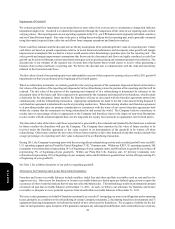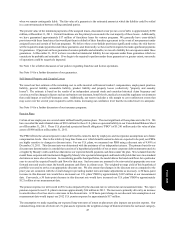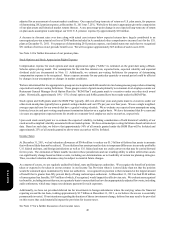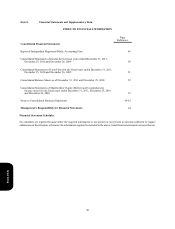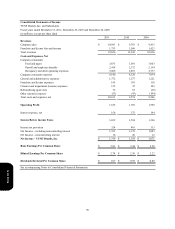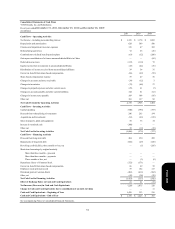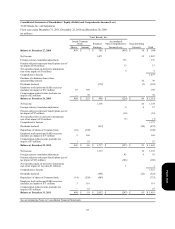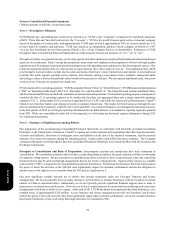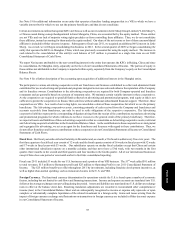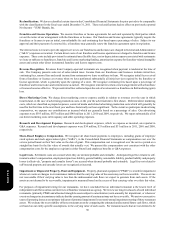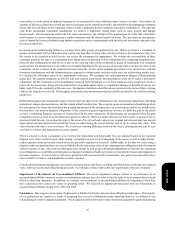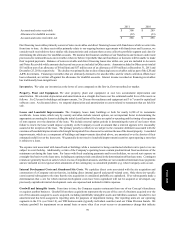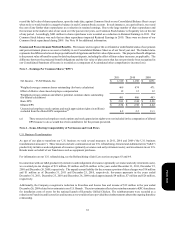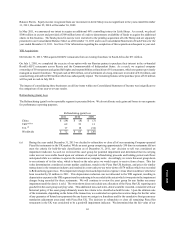Pizza Hut 2011 Annual Report Download - page 158
Download and view the complete annual report
Please find page 158 of the 2011 Pizza Hut annual report below. You can navigate through the pages in the report by either clicking on the pages listed below, or by using the keyword search tool below to find specific information within the annual report.
54
Notes to Consolidated Financial Statements
(Tabular amounts in millions, except share data)
Note 1 – Description of Business
YUM! Brands, Inc. and Subsidiaries (collectively referred to as “YUM” or the “Company”) comprises the worldwide operations
of KFC, Pizza Hut and Taco Bell (collectively the “Concepts”). YUM is the world’s largest quick service restaurant company
based on the number of system units, with approximately 37,000 units of which approximately 50% are located outside the U.S.
in more than 120 countries and territories. YUM was created as an independent, publicly-owned company on October 6, 1997
via a tax-free distribution by our former parent, PepsiCo, Inc., of our Common Stock to its shareholders. References to YUM
throughout these Consolidated Financial Statements are made using the first person notations of “we,” “us” or “our.”
Through our widely-recognized Concepts, we develop, operate, franchise and license a system of both traditional and non-traditional
quick service restaurants. Each Concept has proprietary menu items and emphasizes the preparation of food with high quality
ingredients as well as unique recipes and special seasonings to provide appealing, tasty and attractive food at competitive prices. Our
traditional restaurants feature dine-in, carryout and, in some instances, drive-thru or delivery service. Non-traditional units, which
are principally licensed outlets, include express units and kiosks which have a more limited menu and operate in non-traditional
locations like malls, airports, gasoline service stations, train stations, subways, convenience stores, stadiums, amusement parks
and colleges, where a full-scale traditional outlet would not be practical or efficient. We also operate multibrand units, where two
or more of our Concepts are operated in a single unit.
YUM consists of five operating segments: YUM Restaurants China ("China" or “China Division”), YUM Restaurants International
(“YRI” or “International Division”), KFC U.S., Pizza Hut U.S., and Taco Bell U.S. The China Division includes mainland China,
and the International Division includes the remainder of our international operations. For financial reporting purposes, management
considers the three U.S. operating segments to be similar and, therefore, has aggregated them into a single reportable operating
segment (“U.S.”). In December 2011 we sold our Long John Silver's ("LJS") and A&W All American Food Restaurants ("A&W")
brands to key franchise leaders and strategic investors in separate transactions. The results for these businesses through the sale
date are included in the Company's results for 2011, 2010 and 2009. As a result of changes to our management reporting structure,
in the first quarter of 2012 we will begin reporting information for our India business as a standalone reporting segment separated
from YRI. While our consolidated results will not be impacted, we will restate our historical segment information during 2012
for consistent presentation.
Note 2 – Summary of Significant Accounting Policies
Our preparation of the accompanying Consolidated Financial Statements in conformity with Generally Accepted Accounting
Principles in the United States of America (“GAAP”) requires us to make estimates and assumptions that affect reported amounts
of assets and liabilities, disclosure of contingent assets and liabilities at the date of the financial statements, and the reported
amounts of revenues and expenses during the reporting period. Actual results could differ from these estimates. The Company
evaluated subsequent events through the date the Consolidated Financial Statements were issued and filed with the Securities and
Exchange Commission.
Principles of Consolidation and Basis of Preparation. Intercompany accounts and transactions have been eliminated in
consolidation. We consolidate entities in which we have a controlling financial interest, the usual condition of which is ownership
of a majority voting interest. We also consider for consolidation an entity, in which we have certain interests, where the controlling
financial interest may be achieved through arrangements that do not involve voting interests. Such an entity, known as a variable
interest entity (“VIE”), is required to be consolidated by its primary beneficiary. The primary beneficiary is the entity that possesses
the power to direct the activities of the VIE that most significantly impact its economic performance and has the obligation to
absorb losses or the right to receive benefits from the VIE that are significant to it.
Our most significant variable interests are in entities that operate restaurants under our Concepts’ franchise and license
arrangements. We do not generally have an equity interest in our franchisee or licensee businesses with the exception of certain
entities in China as discussed below. Additionally, we do not typically provide significant financial support such as loans or
guarantees to our franchisees and licensees. However, we do have variable interests in certain franchisees through real estate lease
arrangements with them to which we are a party. At the end of 2011, YUM has future lease payments due from franchisees, on a
nominal basis, of approximately $320 million. As our franchise and license arrangements provide our franchisee and licensee
entities the power to direct the activities that most significantly impact their economic performance, we do not consider ourselves
the primary beneficiary of any such entity that might otherwise be considered a VIE.
Form 10-K


